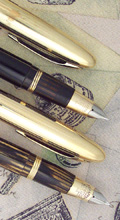
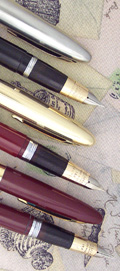
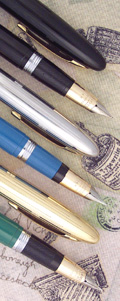
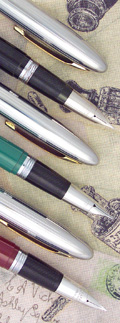











The
Sheaffer Triumph Nib 1942-1998
by Jim
Mamoulides, December 27, 2001

Triumph Pens 1942-1948
Removing the cap of a Triumph nib pen reveals not only a Sheaffer hallmark, but an innovation in design and functionality. The Triumph, also the namesake of the new pen line introduced in 1942, is one of the most unique nibs ever made, developed to be stronger, based on cylindrical design, than a traditional open nib and to have more ink channels, which extend well into the section, in order to have better ink flow in general and better usability at high altitudes. Sheaffer also advertised this "feed-back" design allowed the pen to be carried in any position, as the feed was designed to back flow the ink into the barrel when the pen was not in use.

Sheaffer 1942 Triumph Advertisement
Another innovation of the Triumph nib was a slight upward taper at the end. This was for two purposes, one, like the conical shape, was for strength in writing through carbons so that it would not pierce the paper, the second was to allow the nib to be used upside down with a finer line. This tapering is more pronounced on 1940s Triumphs, which also had generally shorter and fatter nibs, than on TM pens.
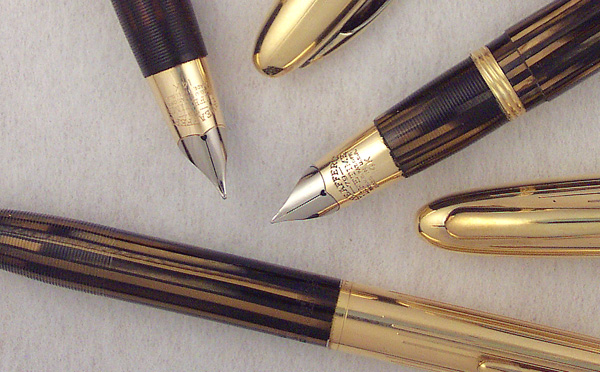
Sheaffer Triumph Pens With Two Tone Triumph Nibs c1944-1945
The new pen continued the trend, started with the Parker 51, toward stiffer and more conical nib and section designs, a strong move away from traditional open nibs. Instead of a hooded traditional nib, as with the 51, Sheaffer opted to redesign the nib to the same effect. The section was also redesigned with grooves for better grip. The earliest Triumph nibs were formed from a flat piece of 14 karat gold and bent into the tube shape and welded. The tip was then plated with palladium, as on the Feathertouch nibs.
Touchdown Pens 1949
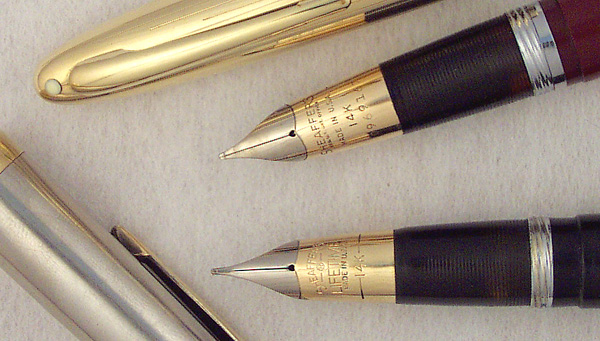
Sheaffer Triumph and Touchdown Two Tone Triumph Nibs c1948-1949
By 1948, Sheaffer redesigned the nib making process and introduced injection molding for the plastic parts. The nib was now drawn from 14 karat gold, in the same manner as seamless tubing, and threaded for mounting on the section. In 1949 Sheaffer introduced the Touchdown filling system, dropping the Triumph name for the pen line. The Lifetime marking on the nib was dropped.
Thin Model Touchdown and Snorkel Pens 1950-1959
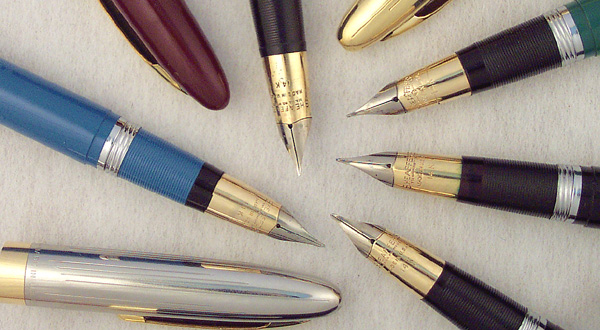
Sheaffer Thin Model Touchdown and Snorkel Two Tone
Triumph Nibs 1950-1959
Sheaffer redesigned the Touchdown in 1950, introducing the Thin Model or TM pen line, and with it a narrower, but longer looking nib. In 1952, Sheaffer introduced the Snorkel filling system, making the pen slightly longer, but without any real change to the nib design.
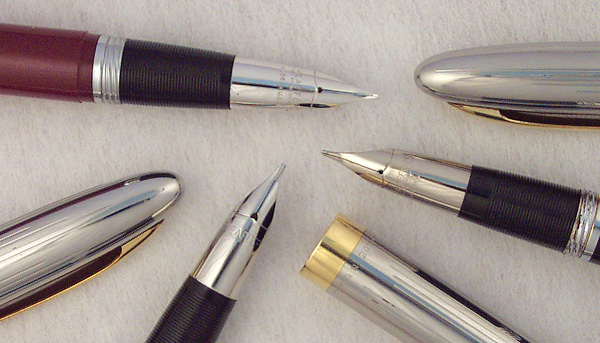
Sheaffer Thin Model Snorkel Palladium Silver Triumph Nibs
1952-1959
In 1952, Sheaffer also introduced several models of the new TM Snorkel with palladium silver alloy Triumph nibs. Some nibs are marked PdAg for the metal content, while others simply have "Sheaffer's" as the sole marking. The palladium silver nibbed pens were "down" models from their same trimmed two-tone gold nibbed cousins, allowing Sheaffer to market numerous versions of essentially the same pen.
Imperial, Stylist, and Cartridge Pens 1964-c1972

Sheaffer Cartridge Pen With Short Triumph Nib c1965
A shortened version of the Triumph nib also appeared on certain Imperial, Stylist and Cartridge models from the mid 1960s to the early 1970s. This nib was made in stainless, gold plate and 14 karat gold. The "Sheaffer's" engraving was shortened to "Sheaffer" c1966.
Crest 1991-1998
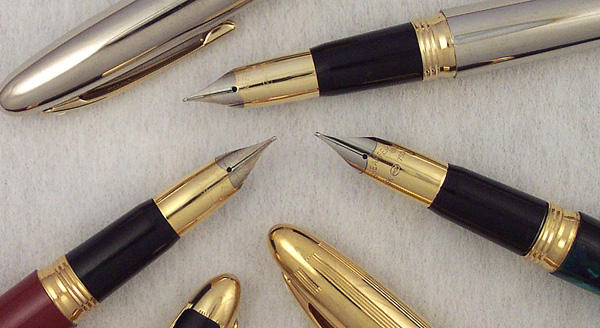
Sheaffer Crest Two Tone Triumph Nibs 1991-1998
In 1991, Sheaffer introduced the Crest line, a cartridge / converter pen that derives its design strongly from the TM Snorkel pens of the 1950s. These pens are fitted with conical 18 karat gold nibs that are nearly identical to the gold two-tone TM nibs.
Comments on this article may be sent
to the author, Jim Mamoulides
PenHero.com Bibliography